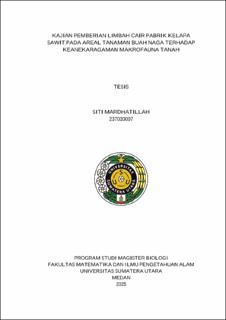| dc.description.abstract | The application of palm oil mill effluent (POME) on dragon fruit plant areas as fertilizer with variations in the application time will affect the presence and diversity of soil macrofauna, which in turn can reflect the varying soil quality. This study aims to analyze the species presence, diversity index, equitability, and similarity of soil macrofauna, as well as the correlation between POME application as fertilizer and the values of the Diversity/Species Richness Index (H’) and Equitability (E) of soil macrofauna. It also examines the physical-chemical and biological soil quality (soil macrofauna and ground vegetation) in dragon fruit plant areas with no application (block I) and those applied with POME (pond 5) PT. Anugrah Tanjung Medan, with application durations of 14 days (block II) and 28 days (block III). The research was conducted at the Taman Buah Al-Asri dragon fruit plantation from June to September 2024, with a sampling interval of 14 days, using the Purposive Sampling method, and macrofauna soil sampling was carried out using Quadrat and Hand Sorting methods. The results of this study identified 52 species of soil macrofauna, which belong to 3 Phyla, 7 Classes, 17 Orders, 28 Families, and 47 Genera. Block I had 28 species, block II had 40 species, and block III had 37 species. The highest H’ value of soil macrofauna was found in block II categorized as 3 (high), followed by block III, and block I, which were categorized as 2 (medium). The E value of soil macrofauna in all three study blocks was classified as high, and the Similarity (S) value between the blocks was also high (S ≥ 50%). The use of POME as fertilizer for 14 days (block II) improved soil quality and had a positive correlation with increased diversity and equitability of soil macrofauna. | en_US |


